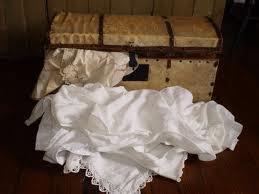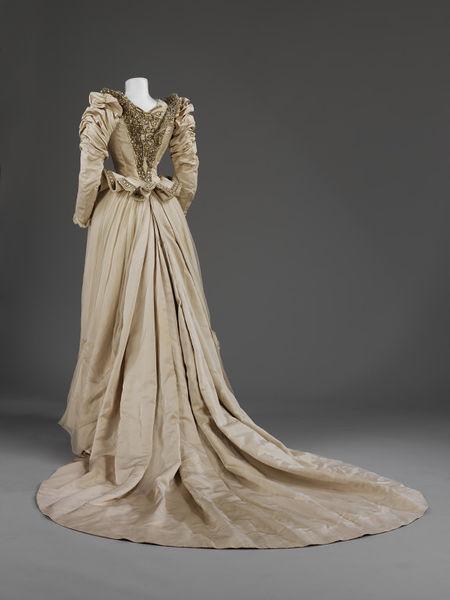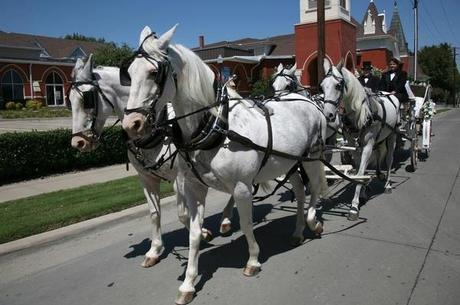Below are a few excerpts from previous blogs that I've written regarding that research. I hope you enjoy!
The Wedding Trousseau
 In Dark Persuasion, because my heroine is blind, her sister is actively involved in preparations for the wedding. One task is helping prepare Charlotte's wedding trousseau.
In Dark Persuasion, because my heroine is blind, her sister is actively involved in preparations for the wedding. One task is helping prepare Charlotte's wedding trousseau.The French word trousseau refers, of course, to a bride's bundle of personal possessions amassed prior to the wedding that include undergarments and clothing. Late in the 19th and early 20th century a collection of household wares (tablecloths, towels, linens, etc.) were also included.
My story is set roughly around the 1885-1890, so Charlotte's collection of personal items deal mainly with fine undergarments and clothing. Below is an excerpt from Vintage Connection describing a typical trousseau around 1884. It would include the following:
"... a dozen chemises trimmed with embroidery or insertions, a dozen nightdresses, six well-trimmed combinations, a dozen drawers, nine trimmed petticoats, one French petticoat, nine camisoles, six vests, five flannel petticoats, two dressing gowns, three bed jackets, a dozen pairs of fine-quality Lisle stockings, three pairs of silk stockings, two dozen handkerchiefs, a pair of French corsets, a bustle, a satin nightdress and a lace-trimmed sachet."
The Wedding
 Everything in the Victorian era seemed to be dictated by proper etiquette. Weddings were no different. There were rules about fashion, the time to wed, and the reception. It was quite an interesting read doing research about the subject. I tried to incorporate as much as I could within my text in hopes of ducking any criticism about getting it all wrong. Here are a few short, but interesting facts.
Everything in the Victorian era seemed to be dictated by proper etiquette. Weddings were no different. There were rules about fashion, the time to wed, and the reception. It was quite an interesting read doing research about the subject. I tried to incorporate as much as I could within my text in hopes of ducking any criticism about getting it all wrong. Here are a few short, but interesting facts.If the bride married in a church, a gown with a long train and a veil of the same length was the style of the era. The veil remained over the bride's face until after the wedding ceremony. I've read conflicting statements regarding kissing at the altar, but I allowed a smooch anyway for my characters.
Pure white had not yet become the standard of choice in wedding dresses. Colors varied. The dress pictured in this post is from roughly 1890. I like to visualize it as Charlotte's dress, my blind heroine, in the story. I love the detailed bodice, the fabric, and the long train (not shown here). Bridesmaids often wore the same color of dress as the bride.
Superstitions abounded. There were rhymes about what day of the week was best to wed, the color of a bride's dress, and, of course, the famous saying: "Something old, something new, something borrowed, something blue, and a lucky sixpence in your shoe." Each item had a meaning and purpose like the sixpence, which was meant to bless the wedding with wealth and prosperity. No one married on Sunday, but the other days all had meaning:Marry on Monday for health
Tuesday for wealth
Wednesday the best day of all
Thursday for crosses
Friday for losses
Saturday for no luck at all.
(Obtained from The Victorian Wedding)
 After the service, the tossing of rice, grain, or birdseed was used for good luck when it came to fertility. If it were a wealthy couple, a carriage drawn by four white horses waited for the bride and groom after the service to take them to the reception. The reception was usually held at the bride's home. Weddings took place in the morning around 11 o'clock, and the reception consisted of a wedding breakfast.
After the service, the tossing of rice, grain, or birdseed was used for good luck when it came to fertility. If it were a wealthy couple, a carriage drawn by four white horses waited for the bride and groom after the service to take them to the reception. The reception was usually held at the bride's home. Weddings took place in the morning around 11 o'clock, and the reception consisted of a wedding breakfast.An area for a receiving line would have been set up for the bride and groom at the reception. Brides were addressed first, unless the guest only knew the groom. In that instance, the groom would introduce the bride. I must laugh when I discovered that the bride was never congratulated, as the honor of marriage was conferred upon her already for agreeing to marry the groom. (Lucky spinster finally finds a husband, I guess.)
Guests enjoyed their breakfast, but there was no entertainment at the reception. Evening receptions, with dancing, only occurred at lavish wedding affairs.
After the reception, the bride changed into another dress for her honeymoon journey. Only the groom and the best man knew the location, which by tradition was a well-kept secret.
There are many websites regarding Victorian-era weddings. The link in this post has quite a bit of detail. However, the Victorian era spanned many years, as you know, so traditions changed somewhat as the years progressed.
Such is the romance of the Victorian ages.
Vicki
